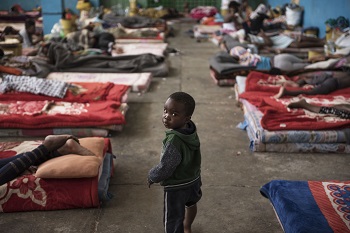Up to three quarters of children and youth face abuse, exploitation and trafficking on Mediterranean migration routes – UNICEF, IOM
Children from sub-Saharan Africa targeted more than any other group, pointing to impact of discrimination and racism Report calls on Europe to establish “safe and regular pathways” for migration
Migrant and refugee children and youth trying to reach Europe face appalling levels of human rights abuses, with 77 per cent of those traveling along the Central Mediterranean route reporting direct experiences of abuse, exploitation, and practices which may amount to human trafficking – UNICEF and IOM, the UN Migration Agency, said in a new report on Sep 12.

A child walks past mattresses laid on the floor in the women's section of the Al-Nasr detention centre in Zawiya, Libya, Sunday 20 August 2017.
Harrowing Journeys shows that while all migrants and refugees are at high risk, children and youth on the move are far more likely to experience exploitation and trafficking than adults aged 25 years and above: nearly twice as likely on the Eastern Mediterranean route and at a rate 13 per cent higher on the Central Mediterranean route.
Aimamo, a 16-year-old unaccompanied child from the Gambia interviewed at a shelter in Italy described being forced into months of grueling manual labor by traffickers upon his arrival in Libya. “If you try to run, they shoot you. If you stop working, they beat you. We were just like slaves. At the end of the day, they just lock you inside.”
The report is based on the testimonies of some 22,000 migrants and refugees, including some 11,000 children and youth, interviewed by IOM.
“The stark reality is that it is now standard practice that children moving through the Mediterranean are abused, trafficked, beaten and discriminated against,” said Afshan Khan, UNICEF Regional Director and Special Coordinator for the Refugee and Migrant Crisis in Europe. “EU leaders should put in place lasting solutions that include safe and legal migration pathways, establishing protection corridors and finding alternatives to the detention of migrant children.”
“For people who leave their countries to escape violence, instability or poverty, the factors pushing them to migrate are severe and they make perilous journeys knowing that they may be forced to pay with their dignity, their wellbeing or even their lives,” said Eugenio Ambrosi, IOM’s Regional Director for the EU, Norway and Switzerland.
“Without the establishment of more regular migration pathways, other measures will be relatively ineffective. We must also re-invigorate a rights-based approach to migration, improving mechanisms to identify and protect the most vulnerable throughout the migration process, regardless of their legal status.”
The report also shows that, while all children on the move are at high risk, those originating from sub-Saharan Africa are far more likely to experience exploitation and trafficking than those from other parts of the world: 65 per cent compared to 15 per cent along the Eastern Mediterranean route, and 83 per cent compared to 56 per cent along the Central Mediterranean route. Racism is likely a major underlying factor behind this discrepancy.
Children and youth traveling alone or over longer periods, along with those possessing lower levels of education, were also found to be highly vulnerable to exploitation at the hands of traffickers and criminal groups over the course of their journeys. According to the report, the Central Mediterranean route is particularly dangerous, with most of the migrants and refugees passing through Libya which remains riven with lawlessness, militias and criminality. On average young people pay between $1,000-5,000 for the journey and often arrive in Europe in debt, which exposes them to further risks.
The report calls on all concerned parties − countries of origin, transit and destination, the African Union, the European Union, international and national organizations with support from the donor community – to prioritize a series of actions.
These include establishing safe and regular pathways for children on the move; strengthening services to protect migrant and refugee children whether in countries of origin, transit or destination; finding alternatives to the detention of children on the move; working across borders to combat trafficking and exploitation; and combatting xenophobia, racism and discrimination against all migrants and refugees.
Source:United Nations Children's Fund
- 284 reads
Human Rights
Ringing FOWPAL’s Peace Bell for the World:Nobel Peace Prize Laureates’ Visions and Actions

Protecting the World’s Cultural Diversity for a Sustainable Future

The Peace Bell Resonates at the 27th Eurasian Economic Summit

Declaration of World Day of the Power of Hope Endorsed by People in 158 Nations

Puppet Show I International Friendship Day 2020

